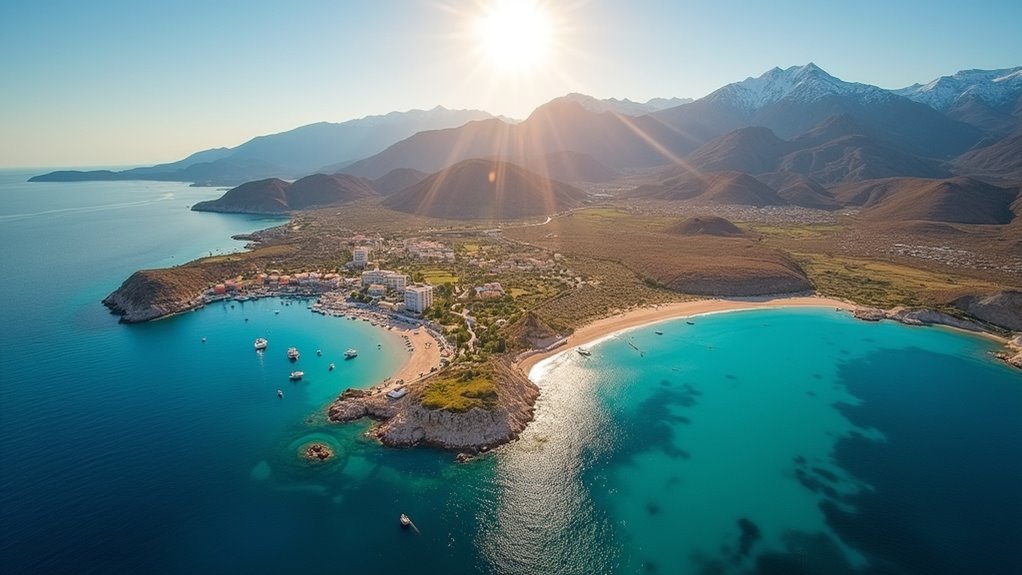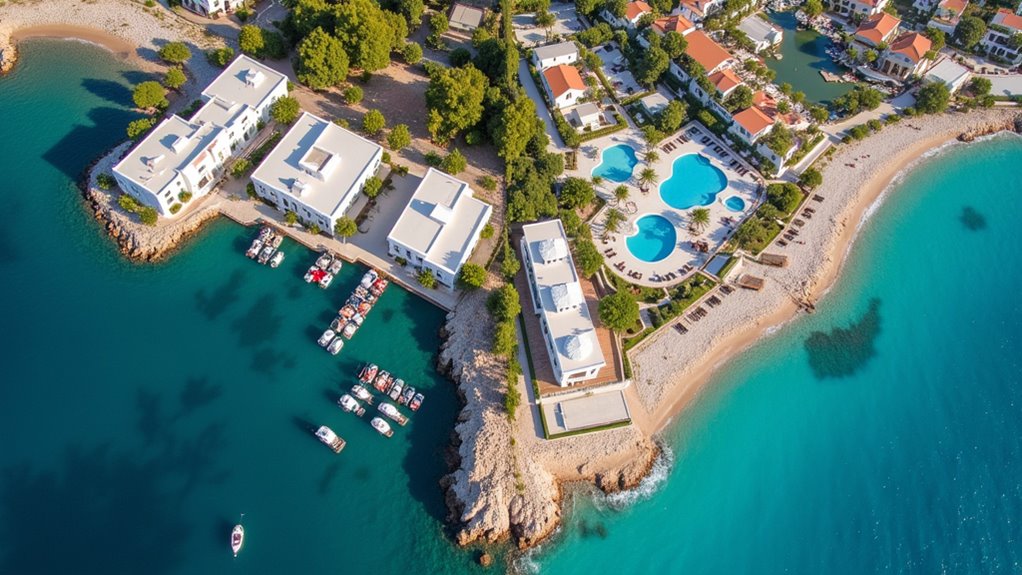Physical Address
304 North Cardinal St.
Dorchester Center, MA 02124
Physical Address
304 North Cardinal St.
Dorchester Center, MA 02124

Choosing between Kos and Crete depends on whether you seek an intimate island escape or a vast historical playground.

When comparing Kos and Crete, the difference in size immediately distinguishes itself. Crete, Greece’s largest island, spans 8,336 km² – nearly 29 times larger than Kos’s modest 290 km². This isn’t just a matter of numbers; you’ll feel it in your travel experience.
Crete boasts an impressive 1,046 km coastline with diverse landscapes featuring dramatic mountains like Mount Ida. You’ll find more geographical variety here than almost anywhere else in Greece. As the fifth largest island in the Mediterranean Sea, Crete offers extensive territory to explore compared to its regional counterparts.
Kos, measuring just 42.1 km by 11.5 km, offers a flatter, more navigable terrain. Unlike Athens with its historical sites spanning millennia, Kos presents a more concentrated historical footprint.
Location-wise, Crete sits about 160 km south of mainland Greece, while Kos belongs to the Dodecanese islands, positioned closer to Turkey.
Both have international airports, but Crete’s two major hubs offer more connectivity than Kos’s single airport.
Although both islands boast classic Mediterranean weather, Kos and Crete have subtle climate differences worth considering for your Greek getaway. You’ll find hot summers and mild winters in both locations, but Kos typically enjoys more sunshine hours and warmer nighttime temperatures than parts of Crete. Like the nearby island of Ios, both destinations feature stunning beach weather that attracts visitors seeking sun-soaked vacations. For a more detailed analysis, WeatherSpark allows you to compare these destinations using unified graphs that highlight their climate variations.
Classic Mediterranean charm with nuanced climate differences – choose Kos for extra sunshine or Crete for diverse microclimates.
Winter brings mild temperatures to both destinations, with southern Crete slightly warmer overall.

While both islands boast spectacular Mediterranean coastlines, Kos and Crete offer distinctly different beach experiences for sun-seekers.
Kos excels with wide, comfortable beaches like Paradise Beach, featuring soft white sand and excellent amenities. You’ll find Marmari perfect for windsurfing, family-friendly Kardamena, and peaceful Kefalos for jet skiing enthusiasts.
Crete, meanwhile, delivers more diverse coastal landscapes. You can explore the famous pink sands of Elafonisi, the turquoise lagoon at Balos, or the palm-lined Vai Beach. Many travelers agree that Crete is worth visiting now for its unmatched beach diversity alone. The southwest coast of Crete around Paleochora offers quieter, scenic beaches with access to charming original villages and natural attractions.
For something unique, visit Matala with its fascinating caves and hippie heritage.
If you’re after easy access and relaxation, Kos beaches won’t disappoint. But if you crave variety and don’t mind a bit more exploration, Crete’s coastal offerings will reward your adventurous spirit.
Beyond their beautiful beaches, Kos and Crete stand as living museums, showcasing Greece’s opulent historical tapestry through remarkably different collections of cultural treasures.
While Greece’s islands beckon with azure waters, their ancient stones whisper secrets of civilizations past.
Kos proudly displays its connection to Hippocrates, with his legendary teaching tree and the Asclepieion healing sanctuary offering glimpses into ancient medicine’s birthplace. Meanwhile, Crete dazzles with Knossos Palace – the mythical labyrinth of the Minotaur – representing one of Greece’s most significant archaeological sites.
Key differences to contemplate:
Visitors to Kos can explore the remarkable Roman Odeon and Archaeological Ruins which combine ancient architecture with cultural history through restored villa structures and gymnasium remains. Families traveling to Kos will find many of these historical sites offer family-friendly adventures that engage children while introducing them to Greek heritage.

After exploring the ancient wonders of both islands, you’ll need a comfortable place to rest your head. Both destinations offer accommodations ranging from $20 budget stays to $200+ luxury resorts.
Kos shines with family-friendly options like Mitsis Family Village and excellent cycling infrastructure. Visitors particularly appreciate the apartment hotels offering home-like comfort with additional amenities and privacy. You’ll find well-equipped beaches with amenities and modern resorts featuring spas and fitness centers.
Crete boasts an extensive transportation network, making exploration easier. You’ll discover traditional village houses and boutique hotels alongside high-end beachfront resorts near Elafonisi and Balos. Greece consistently ranks as a must-visit destination for travelers seeking diverse accommodation experiences.
The island also supports digital nomads with reliable Wi-Fi and offers lively nightlife in Chania and Heraklion.
Both islands provide excellent tourist facilities, though Crete’s larger size means more accommodation capacity overall.
When it comes to Greek island vacations, food often becomes a cherished memory that lingers long after your suntan fades. Both Kos and Crete offer mouthwatering Mediterranean cuisine, but with distinct personalities.
Kos blends Greek classics with Turkish and Italian influences. You’ll find family-run tavernas serving generous portions of moussaka, unique pitardia cheese pies, and wine-matured posa cheese. Kos Town is particularly renowned for its top-rated restaurants offering authentic Greek dining experiences with exceptional service. Don’t miss the local cinnamon liquor, kanelada!
Crete’s cuisine is more deeply rooted in ancient traditions with:
While Kos offers budget-friendly, tourist-accessible dining, Crete provides a wider range of experiences from village tavernas to upscale gourmet venues. As the ancient Greeks would say, timeless wisdom about food being medicine is particularly evident in Cretan cuisine with its heart-healthy olive oil and fresh ingredients.

How you’ll get around your chosen Greek island can considerably shape your vacation experience. Kos shines with its efficient public transportation network, making beaches and cultural sites easily accessible without a car. You’ll find well-maintained roads and a bike-friendly environment perfect for exploring this compact island.
Crete, while offering decent public transit, often requires a car for thorough exploration. Its larger size and more diverse terrain mean some of the most stunning beaches and archaeological treasures are harder to reach without your own wheels. Crete’s significantly higher infrastructure score of 85/100 makes navigating this largest Greek island more manageable despite its size challenges. Travelers on a tight budget may appreciate that both destinations offer budget-friendly options for getting around without breaking the bank.
Both islands offer affordable public transportation, though services decrease during off-season. If you’re a walker or cyclist who prefers to leave the driving to others, Kos offers more convenience.
For those who enjoy road trips and the freedom to discover hidden spots, Crete delivers more adventure.
Understanding current tourism patterns can help you make an informed choice between these popular Greek destinations. Both islands are riding the wave of Greece’s tourism boom, with an 8% average rise in summer bookings nationwide for 2025.
Crete stands as the third most preferred destination for UK travelers, with bookings increasing 7.1% compared to 2023. Meanwhile, Kos ranks seventh in British preferences but continues to grow in popularity. You’ll notice this reflected in prices too, with tourism packages up about 5% across Greece.
Both islands offer excellent family-friendly options for travelers with children seeking relaxing beach holidays.
Key trends to consider:
You’ll find a Greek paradise either way you go. Crete welcomes about 5 million visitors annually compared to Kos’s 1 million, showing just how much bigger an experience it offers. If you’ve got time to explore and crave variety, head to Crete. If you want a compact, beach-focused holiday where everything’s nearby, Kos is your ticket. Trust your gut—both islands deliver authentic Greek magic.